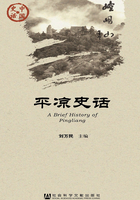Unhappily the artificial features of the system have been made by modern inquirers the starting point of very far-reaching theories and suppositions. Seebohm has proposed an explanation of the intermixture of strips as originating in the practice of coaration. He argues that it was natural to divide the land tilled by a mixed plough-team among the owners of the several beasts and implements. Every man got a strip according to a certain settled and ever-recurring succession. I do not pretend to judge of the value of the interesting instances adduced by Seebohm from Celtic practices, but whatever the arrangement in Wales or Ireland may have been, the explanation does not suit the English case. A doubt is cast on it already by the fact that such a universal feature as the intermixture of strips appears connected with the occurrence of such a special instrument as the eight-oxen plough, The intermixture is quite the same in Central Russia, where they till with one horse, and in England where more or less big ploughs were used. the doubt increases when we reflect that if the strips followed each other as parts of the plough-team, the great owners would have been possessed of compact plots. Every holder of an entire hide would have been out of the intermixture, and every virgater would have stood in conjunction with a sequence of three other tenants. Neither the one nor the other inference is supported by the facts. The observation that the peasantry are commonly provided with small ploughs drawn by four beasts ruins Seebohm's hypothesis entirely.
One would have to suppose that most fields were divided into two parts, as the majority of the tenements are yardlands with half a team. The only adequate explanation of the open-field intermixture has been given above; it has its roots in the wish to equalise the holdings as to the quantity and quality of the land assigned to them in spite of all differences in the shape, the position, and the value of the soil.
Before I leave the question as to the holdings of the feudal peasantry, I must mention some terms which occur in different parts of England, although more rarely than the usual hides and virgates.(64*) Of the sulung I have spoken already. It is a full ploughland, and 200 acres are commonly reckoned to belong to it.
The name is sometimes found out of Kent, in Essex for instance.
In Tillingham, a manor of St. Paul's of London, we come across six hides 'trium solandarum'.(65*) The most probable explanation seems to be that the hide or unit of assessment is contrasted with the solanda or sulland (sulung), that is with the actual ploughland, and two hides are reckoned as a single solanda.
The yokes (juga) of Battle Abbey (66*) are not virgates, but carucates, full ploughlands. This follows from the fact that a certain virgate mentioned in the record is equivalent only to one fourth of the yoke. In the Norfolk manors of Ely Minster we find tenmanlands (67*) of 120 acres in the possession of several copartitioners, participes. The survey does not go into a detailed description of tenements and rights, and the reckoning of services starts from the entire combination, as in the Kentish documents. A commonly recurrent term is wista;(68*) it corresponds to the virgate: a great wista is as much as half-a-hide, or two virgates.(69*)The terms discussed hitherto are applied to the tenements in the fields of the village; but besides those there are other names for the plots occupied by a numerous population which did not find a place in the regular holdings. There were craftsmen and rural labourers working for the lord and for the tenants;there were people living by gardening and the raising of vegetables. This class is always contrasted with the tenants in the fields. The usual name for their plots is cote, cotland, or cotsetland. The so-called ferdel, or fourth part of a virgate, is usually mentioned among them because there are no ploughbeasts on it.(70*) Another name for the ferdel is nook.(71*) Next come the crofters, whose gardens sometimes extend to a very fair size --as much as ten acres in one enclosed patch.(72*) The cotters proper have generally one, two, and sometimes as much as five acres with their dwellings; they cannot keep themselves on this, as a rule, and have to look out for more on other people's tenements. A very common name for their plots is 'lundinaria'(73*) 'Mondaylands,' because the holders are bound to work for the lord only one day in the week, usually on Monday.
Although the absence of plough-beasts, of a part in coaration, and of shares in the common fields draws a sharp line between these men and the regular holders, our surveys try sometimes to fit their duties and plots into the arrangement of holdings; the cotland is assumed to represent one sixteenth or even one thirty-second part of the hide.(74*) The Glastonbury Survey of 1189 contains a curious hint that two cottages are more valuable than one half-virgate: two cotlands were ruined during the war, and they were thrown together into half a virgate, although it would have been more advantageous to keep two houses on them, that is two households.(75*) The bordae mentioned by the documents are simply cottages or booths without any land belonging to them.(76*) The manorial police keeps a lookout that such houses may not arise without licence and service.(77*)A good many terms are not connected in any way with the general arrangement of the holdings, but depend upon the part played by the land in husbandry or the services imposed upon it.















